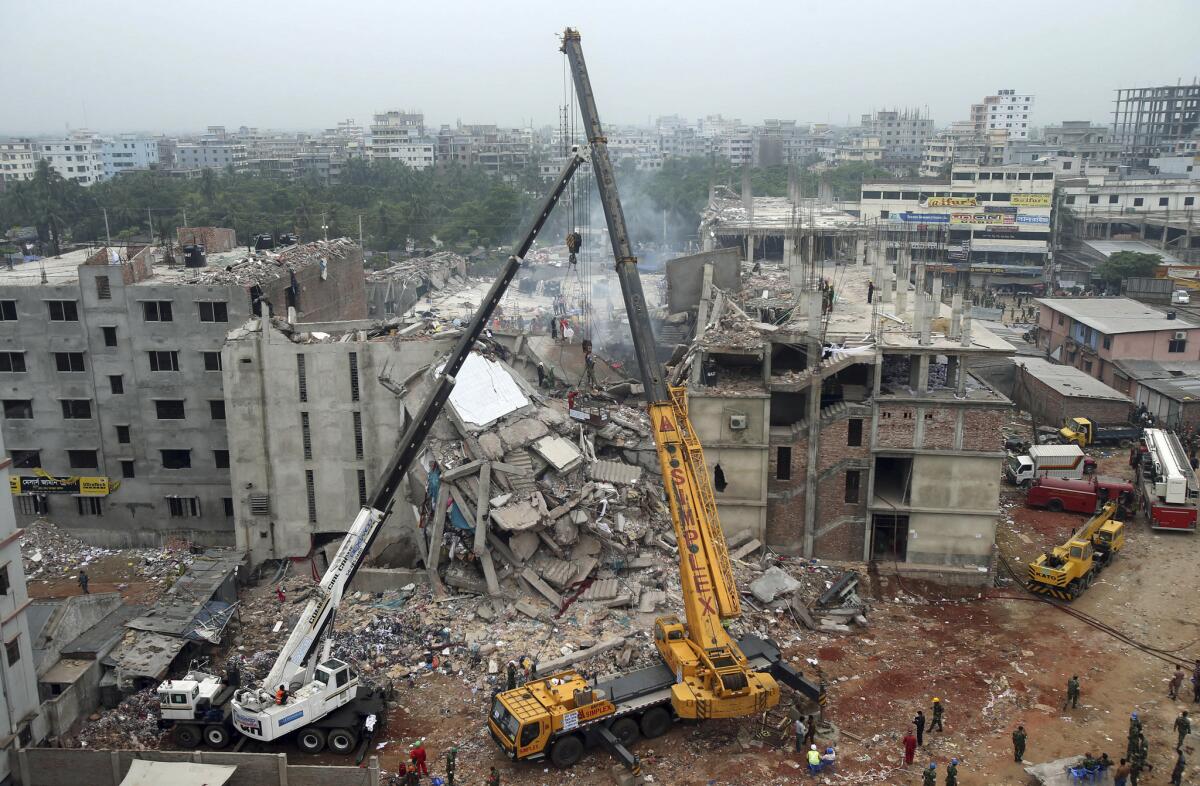After Rana Plaza tragedy, report finds more garment industry reform needed

Friday marks two years since a garment factory collapsed at Rana Plaza near Dhaka, Bangladesh, killing more than 1,100 workers. The tragedy occurred just five months after a factory fire at Tazreen Fashions on the outskirts of Dhaka killed 112 workers and injured several hundred others.
In the aftermath, a Human Rights Watch report released Wednesday says Western retailers and the Bangladesh government have still not done enough to protect workers’ rights or ensure their safety and well-being.
The 78-page report, titled “Whoever Raises Their Head Suffers the Most,” documents continuing violations of workers’ rights in Bangladesh, details anti-union tactics by managers “and shows the inadequacy of efforts to date to compensate victims of the Rana Plaza collapse,” according to a summary.
It concludes with recommendations for the Bangladeshi government, local trade associations, Western apparel companies and the international community. Among other things, the recommendations call for regular and better factory inspections; support of workers’ rights to join labor unions; and creation of a “whistle-blower” protection system for workers and labor organizers.
Apparel companies are also called upon to ensure that their “pricing and sourcing contracts adequately reflect and incorporate the cost of labor, health, and safety compliance in consultation with labor rights lawyers and unions. This should include the cost of the minimum wage, overtime payments, and all legal benefits.” In other words, don’t exploit workers to keep fast-fashion prices low.
A fund set up to help survivors of Rana Plaza has fallen about $9 million short of the $30-million goal, and the report points out that while some Western companies with ties to the factory have given generously (British retailer Primark is name-checked for giving $14 million), at least 15 others have not contributed.
Bangladesh is the world’s second largest exporter of garments after China, and the stakes are high for workers, the country’s economy (the garment business accounts for 10% of gross domestic product) and retailers.
The tragedies have inspired some consumers and apparel companies to pay more attention to how and where clothes are made and sparked increasing interest in the so-called “slow clothing” industry, which we profiled here a few days ago.
Groups from 71 countries plan to participate on Friday in the second annual Fashion Revolution Day, which began as a response to the tragedies. People are asked to examine their clothing labels -- perhaps wear clothes inside out to expose the labels -- and to take selfies showing the label, to tag the brand and ask #whomademyclothes on social media.
The aim is to encourage apparel companies to be more forthcoming about their supply chains -- where raw materials came from and who did the work.
Maxine Bédat and Soraya Darabi, the co-founders of slow-fashion brand Zady, are the U.S. chairs of Fashion Revolution Day. In honor of the day, the brand launched a new T-shirt, the .02, made in the U.S. of organic cotton, and all this week they are sharing details about how it is produced on the Zady website. It makes for surprisingly interesting reading, taking you on the shirt’s journey from cotton fields in Lubbock, Texas, to yarn spinning in Thomasville, N.C., to knitting in Clover, S.C., and Lincolntown, N.C., to cutting and sewing in Morgantown, N.C., and printing and dying in Burlington, N.C. It even reveals how the label is made.
At the end you realize that $36 for a T-shirt like this one is a bargain. And why paying anything less may come at too great a cost for someone along the supply chain.
More to Read
Start your day right
Sign up for Essential California for news, features and recommendations from the L.A. Times and beyond in your inbox six days a week.
You may occasionally receive promotional content from the Los Angeles Times.







